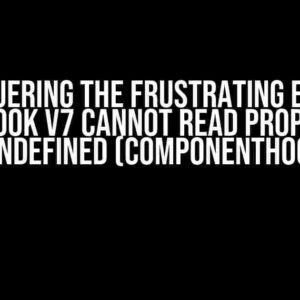Are you tired of being limited by the constraints of DecodeAudioData when it comes to playing audio in your ReactJS application? Well, you’re in luck! In this article, we’ll delve into the world of alternative methods for playing audio in the browser, sans DecodeAudioData. Get ready to unlock the full potential of audio playback in your ReactJS project!
The Limitations of DecodeAudioData
Before we dive into the alternatives, let’s take a quick look at why DecodeAudioData might not be the best fit for your audio playback needs. DecodeAudioData is a part of the Web Audio API, which allows developers to decode audio data and play it back in the browser. However, it has some limitations:
- Limited format support: DecodeAudioData only supports a limited range of audio formats, such as WAV and MP3.
- Complexity: Working with DecodeAudioData requires a solid understanding of the Web Audio API, which can be overwhelming for developers new to audio processing.
- Performance issues: DecodeAudioData can be resource-intensive, leading to performance issues on lower-end devices.
Alternative 1: Using the Audio Element
The <audio> element is a simple and straightforward way to play audio in the browser. It’s supported by all modern browsers and is easy to implement in your ReactJS application.
import React from 'react';
const AudioPlayer = () => {
return (
<audio controls>
<source src="audio_file.mp3" type="audio/mpeg">
Your browser does not support the audio element.
</audio>
);
};
In the above example, we create an <audio> element and specify the source of the audio file using the <source> element. The controls attribute adds playback controls to the audio element, allowing users to play, pause, and adjust the volume.
Pros and Cons of Using the Audio Element
| Pros | Cons |
|---|---|
| Easy to implement | Limited customization options |
| Wide browser support | No support for advanced audio processing |
| Simple to manage playback | Limited control over playback behavior |
Alternative 2: Using a Library like Howler.js
Howler.js is a popular JavaScript library that provides a simple and intuitive way to play audio in the browser. It’s lightweight, easy to use, and offers advanced features like spatial audio and playback management.
import React from 'react';
import Howler from 'howler';
const AudioPlayer = () => {
const sound = new Howler({
src: ['audio_file.mp3'],
autoplay: true,
loop: true,
});
return (
<div>
<button onClick={() => sound.play()}>Play</button>
<button onClick={() => sound.pause()}>Pause</button>
</div>
);
};
In the above example, we create a new instance of the Howler sound object, specifying the source of the audio file and setting autoplay and loop options. We then use React to render playback controls that interact with the Howler sound object.
Pros and Cons of Using Howler.js
| Pros | Cons |
|---|---|
| Easy to implement | Additional library dependency |
| Advanced features like spatial audio | May require additional configuration |
| Lightweight and performant | Limited support for older browsers |
Alternative 3: Using a Library like Pizzicato.js
Pizzicato.js is another popular JavaScript library that provides a robust and feature-rich way to play audio in the browser. It’s built on top of the Web Audio API and offers advanced features like effects chains and audio graph management.
import React from 'react';
import Pizzicato from 'pizzicato';
const AudioPlayer = () => {
const audioFile = new Pizzicato.Sound({
source: 'file',
options: {
path: 'audio_file.mp3',
},
});
audioFile.play();
return (
<div>
<button onClick={() => audioFile.play()}>Play</button>
<button onClick={() => audioFile.pause()}>Pause</button>
</div>
);
};
In the above example, we create a new instance of the Pizzicato Sound object, specifying the source of the audio file and setting playback options. We then use React to render playback controls that interact with the Pizzicato Sound object.
Pros and Cons of Using Pizzicato.js
| Pros | Cons |
|---|---|
| Robust feature set | Steeper learning curve |
| Advanced audio processing capabilities | May require additional configuration |
| Performant and efficient | Limited support for older browsers |
Conclusion
In conclusion, there are several alternatives to DecodeAudioData for playing audio in the browser using ReactJS. Each alternative has its pros and cons, and the choice ultimately depends on your specific use case and requirements.
Whether you opt for the simplicity of the <audio> element, the advanced features of Howler.js, or the robust capabilities of Pizzicato.js, you’ll be well on your way to delivering an exceptional audio experience to your users.
So, go ahead and break free from the constraints of DecodeAudioData. Explore the world of alternative audio playback methods, and unlock the full potential of audio playback in your ReactJS application!
Here are 5 FAQs about playing audio in a browser using ReactJS, excluding the use of DecodeAudioData:
Frequently Asked Questions
Got questions about playing audio in a browser using ReactJS without DecodeAudioData? We’ve got you covered!
Is there a way to play audio in the browser using ReactJS without DecodeAudioData?
Yes, there are several alternatives to playing audio in a browser using ReactJS without DecodeAudioData. One popular method is to use the Web Audio API, which provides a powerful way to manipulate audio in the browser.
What is the Web Audio API, and how can I use it to play audio in my ReactJS application?
The Web Audio API is a low-level API that allows you to create and manipulate audio in the browser. You can use it to play audio files, generate audio programmatically, and even create complex audio effects. In your ReactJS application, you can use the Web Audio API by creating an AudioContext, loading an audio file into an AudioBuffer, and then playing the audio using an AudioBufferSourceNode.
Are there any ReactJS libraries that can help me play audio in the browser without using DecodeAudioData?
Yes, there are several ReactJS libraries that can help you play audio in the browser without using DecodeAudioData. Some popular libraries include react-audio-player, react-sound, and react-howler. These libraries provide a simple and easy-to-use API for playing audio in your ReactJS application.
Can I use HTML5 audio elements to play audio in my ReactJS application?
Yes, you can use HTML5 audio elements to play audio in your ReactJS application. The audio element provides a simple way to play audio files in the browser, and can be easily integrated into your ReactJS application using JSX.
What are the advantages of using the Web Audio API over other methods for playing audio in a browser?
The Web Audio API provides a more powerful and flexible way to play audio in the browser compared to other methods. It allows for low-level manipulation of audio, provides better performance and latency, and supports advanced audio features such as audio effects and spatial audio.




